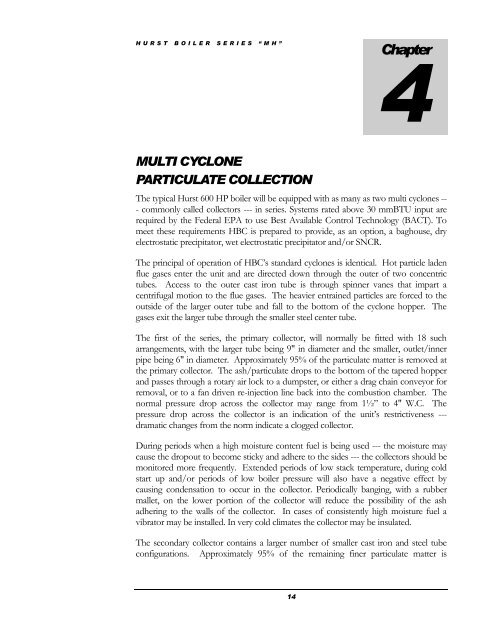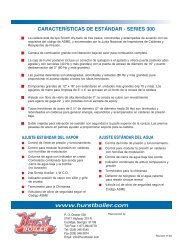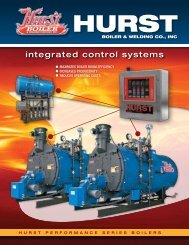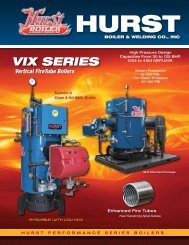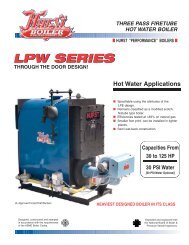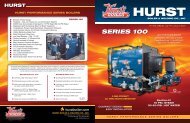Component & System Guide - Hurst Boiler
Component & System Guide - Hurst Boiler
Component & System Guide - Hurst Boiler
You also want an ePaper? Increase the reach of your titles
YUMPU automatically turns print PDFs into web optimized ePapers that Google loves.
H U R S T B O I L E R S E R I E S “ M H ”<br />
MULTI CYCLONE<br />
PARTICULATE COLLECTION<br />
The typical <strong>Hurst</strong> 600 HP boiler will be equipped with as many as two multi cyclones --<br />
- commonly called collectors --- in series. <strong>System</strong>s rated above 30 mmBTU input are<br />
required by the Federal EPA to use Best Available Control Technology (BACT). To<br />
meet these requirements HBC is prepared to provide, as an option, a baghouse, dry<br />
electrostatic precipitator, wet electrostatic precipitator and/or SNCR.<br />
The principal of operation of HBC’s standard cyclones is identical. Hot particle laden<br />
flue gases enter the unit and are directed down through the outer of two concentric<br />
tubes. Access to the outer cast iron tube is through spinner vanes that impart a<br />
centrifugal motion to the flue gases. The heavier entrained particles are forced to the<br />
outside of the larger outer tube and fall to the bottom of the cyclone hopper. The<br />
gases exit the larger tube through the smaller steel center tube.<br />
The first of the series, the primary collector, will normally be fitted with 18 such<br />
arrangements, with the larger tube being 9" in diameter and the smaller, outlet/inner<br />
pipe being 6" in diameter. Approximately 95% of the particulate matter is removed at<br />
the primary collector. The ash/particulate drops to the bottom of the tapered hopper<br />
and passes through a rotary air lock to a dumpster, or either a drag chain conveyor for<br />
removal, or to a fan driven re-injection line back into the combustion chamber. The<br />
normal pressure drop across the collector may range from 1½” to 4" W.C. The<br />
pressure drop across the collector is an indication of the unit’s restrictiveness ---<br />
dramatic changes from the norm indicate a clogged collector.<br />
During periods when a high moisture content fuel is being used --- the moisture may<br />
cause the dropout to become sticky and adhere to the sides --- the collectors should be<br />
monitored more frequently. Extended periods of low stack temperature, during cold<br />
start up and/or periods of low boiler pressure will also have a negative effect by<br />
causing condensation to occur in the collector. Periodically banging, with a rubber<br />
mallet, on the lower portion of the collector will reduce the possibility of the ash<br />
adhering to the walls of the collector. In cases of consistently high moisture fuel a<br />
vibrator may be installed. In very cold climates the collector may be insulated.<br />
The secondary collector contains a larger number of smaller cast iron and steel tube<br />
configurations. Approximately 95% of the remaining finer particulate matter is<br />
14<br />
Chapter<br />
4


